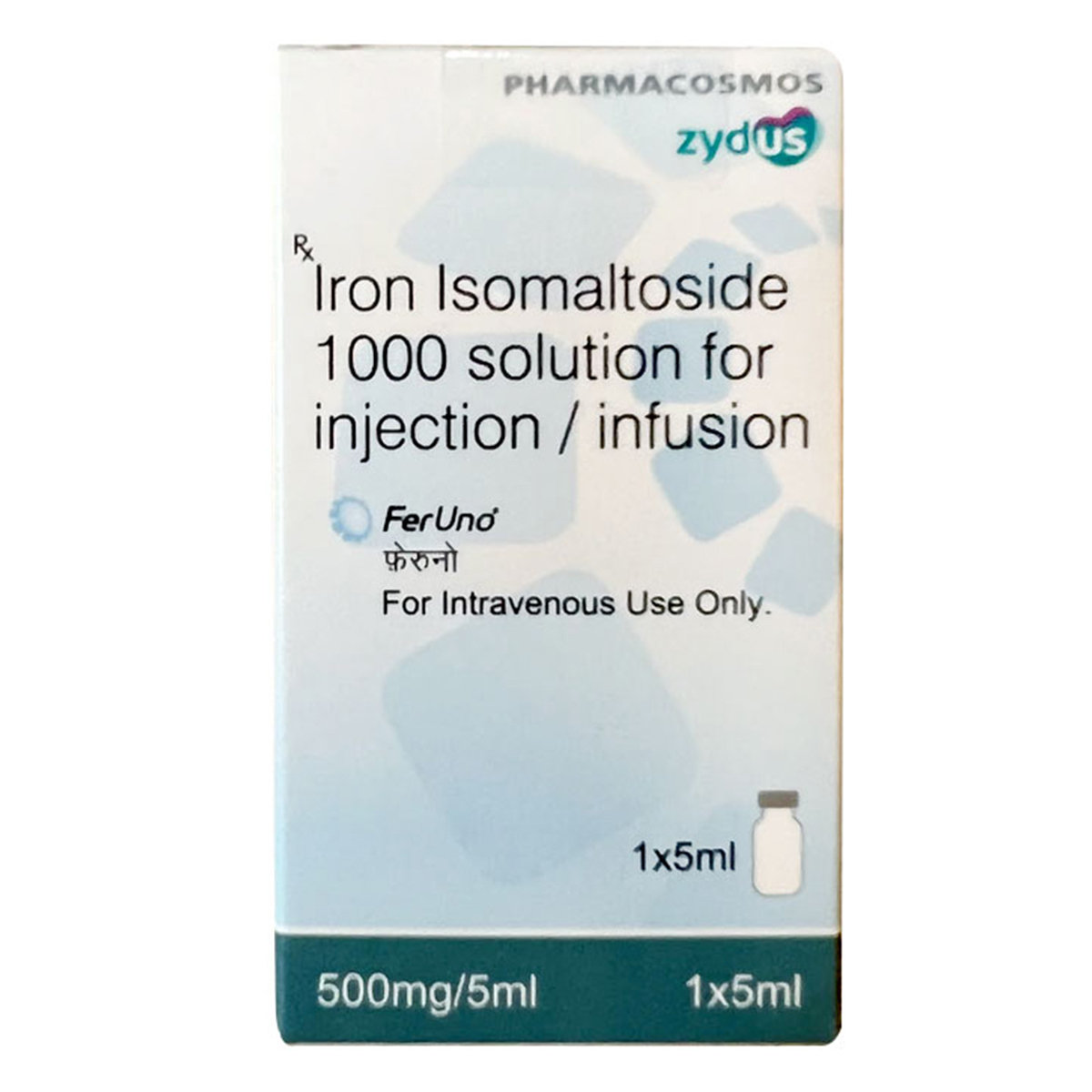Feruno 500 mg/5 ml Injection

MRP ₹3138.5
(Inclusive of all Taxes)
₹156.9 Cashback (5%)
know your delivery time
Provide Delivery Location
Composition :
Manufacturer/Marketer :
Consume Type :
Expires on or after :
Return Policy :

Secure Payment

Trusted by 8 Crore Indians

Genuine Products
Therapeutic Class
Country of origin
Manufacturer/Marketer address
Author Details
We provide you with authentic, trustworthy and relevant information
Disclaimer
Alcohol
Safe if prescribed
There are no studies on how Feruno 500 mg/5 ml Injection is affected by alcohol consumption. Please consult your doctor for more information.
Pregnancy
Consult your doctor
Feruno 500 mg/5 ml Injection should be used during pregnancy only when advised by the doctor. Please let your doctor know if you are pregnant or planning to conceive before starting Feruno 500 mg/5 ml Injection.
Breast Feeding
Consult your doctor
Feruno 500 mg/5 ml Injection may pass into breast milk. Please consult your doctor before taking Feruno 500 mg/5 ml Injection if you are a nursing mother.
Driving
Safe if prescribed
There is limited information on how Feruno 500 mg/5 ml Injection affects driving ability; please seek medical advice.
Liver
Consult your doctor
Let your doctor know if you have any history of liver diseases before taking Feruno 500 mg/5 ml Injection.
Kidney
Consult your doctor
Seek doctor advice before starting Feruno 500 mg/5 ml Injection if you have kidney diseases.
Children
Safe if prescribed
Feruno 500 mg/5 ml Injection is not recommended in children and adolescents below 18 years of age.
Reference
- https://www.accessdata.fda.gov/drugsatfda_docs/label/2020/208171s000lbl.pdf
- https://www.medicines.org.uk/EMC/medicine/23669/SPC/Monofer+100mg+ml+solution+for+injection+infusion/#PHARMACOLOGICAL_PROPS
- https://go.drugbank.com/drugs/DB15617
- https://www.webmd.com/drugs/2/drug-174671/ferric-derisomaltose-intravenous/details
About Feruno 500 mg/5 ml Injection
Feruno 500 mg/5 ml Injection belongs to the class of 'haematinics,' primarily used to treat iron deficiency anaemia. It is useful to treat anaemia in patients with long-term kidney diseases. Iron deficiency anaemia is a condition in which the body does not have enough red blood cells to carry adequate oxygen required to various body tissues due to insufficient iron.
Feruno 500 mg/5 ml Injection contains Iron (III) isomaltoside 1000/Ferric derisomaltose, an iron replacement product required by the red blood cells to carry oxygen to other body cells and tissues. Iron isomaltoside is a compound that releases iron, which binds to transferrin, a transport protein. The transferrin takes the iron to erythroid precursor cells (cells that develop into mature red blood cells) for incorporation into the haemoglobin molecule.
Your doctor will decide the dosage and duration based on your medical condition. In some cases, it may cause side effects like nausea, rash, pain and swelling at the injection site. Most of these side effects of Feruno 500 mg/5 ml Injection do not require medical attention and gradually resolve over time. However, if these side effects persist longer, please consult your doctor.
Brief your medical history to the doctor if you have any heart, liver or kidney diseases, iron overload disorders like hemochromatosis, immune system disorders (lupus), low blood pressure, rheumatoid arthritis, asthma, and eczema before starting Feruno 500 mg/5 ml Injection. Pregnant and breastfeeding women should consult the doctor before starting Feruno 500 mg/5 ml Injection. Feruno 500 mg/5 ml Injection is not recommended in children and adolescents below 18 years of age.
Uses of Feruno 500 mg/5 ml Injection
Medicinal Benefits Mweb
Key Benefits
Feruno 500 mg/5 ml Injection is used to treat iron-deficiency anemia. It contains Iron (III) isomaltoside 1000/Ferric derisomaltose. Iron isomaltoside is a compound that releases iron, which binds to transferrin, a transport protein. The transferrin takes the iron to erythroid precursor cells for incorporation into the haemoglobin molecule. Feruno 500 mg/5 ml Injection is intended for use in patients with kidney diseases, including those who may or may not require dialysis. It is generally used in patients for whom oral forms of iron are not suitable or ineffective.
Directions for Use
Side Effects of Feruno 500 mg/5 ml Injection
- Nausea
- Rash
- Pain and swelling at the injection site
Drug Warnings
Let your doctor know if you are allergic to any of the components in Feruno 500 mg/5 ml Injection. Brief your medical history to the doctor if you have any heart, liver or kidney diseases, low blood pressure, iron overload disorders like hemochromatosis, or immune system disorders like lupus, rheumatoid arthritis, asthma, and eczema before starting Feruno 500 mg/5 ml Injection. Pregnant and breastfeeding women should consult the doctor before starting Feruno 500 mg/5 ml Injection. Feruno 500 mg/5 ml Injection is not recommended in children and adolescents below 18 years of age.
Drug-Drug Interactions
Drug-Drug Interactions
Login/Sign Up
Coadministration of Dimercaprol with Feruno 500 mg/5 ml Injection can increase the risk of developing kidney problems.
How to manage the interaction:
Although there is an interaction between Feruno 500 mg/5 ml Injection and dimercaprol, they can be taken together if prescribed by a doctor. Do not discontinue any medications without consulting a doctor.
Taking Enalapril and Ferric Carboxymaltoside increases the side effects of enalapril.
How to manage the interaction:
Although taking Enalapril with Feruno 500 mg/5 ml Injection may possibly result in an interaction, they can be taken together if prescribed by your doctor. However, if you experience dizziness, lightheadedness, headache, blurred vision, or chest pain, consult your doctor immediately. Do not discontinue any medications without consulting your doctor.
Drug-Food Interactions
Drug-Food Interactions
Login/Sign Up
Drug-Diseases Interactions
Drug-Diseases Interactions
Login/Sign Up
Drug-Drug Interactions Checker List
- DIMERCAPROL
Habit Forming
Diet & Lifestyle Advise
- Include red meat, pork, poultry, and seafood in your diet.
- Iron sources like kidney beans, black beans, spinach, raisins, apricots, and lentils will help improve iron deficiency.
- Also, include iron-fortified cereals, bread, and pasta timely in your regular food intake.
- Vitamin C foods like orange juice, broccoli, strawberries, melons, and bell peppers enhance iron absorption into the body.
- You can also try iron gummies if you have sweet cravings.
- Recent trends, like using cast iron utensils for cooking, can also improve your iron levels.

Have a query?
Buy best Health & Nutrition products by
Vlado Sky Enterprise Pvt Ltd
Abbott India Ltd
Sun Pharmaceutical Industries Ltd
Apollo Healthco Limited
Zydus Healthcare Ltd
Macleods Pharmaceuticals Ltd
West Coast Pharmaceuticals Pvt Ltd
Intas Pharmaceuticals Ltd
Mankind Pharma Pvt Ltd
Meyer Organics Pvt Ltd
Emcure Pharmaceuticals Ltd
Lupin Ltd
Alkem Laboratories Ltd
Nutritionalab Pvt Ltd
Eris Life Sciences Ltd
Akumentis Healthcare Ltd
British Biologicals
La Renon Healthcare Pvt Ltd
Cipla Ltd
Micro Labs Ltd
Zuventus Healthcare Ltd
Torrent Pharmaceuticals Ltd
Pharmed Ltd
Dr Reddy's Laboratories Ltd
Modi Mundipharma Pvt Ltd
Corona Remedies Pvt Ltd
Hindustan Unilever Ltd
Indchemie Health Specialities Pvt Ltd
Apex Laboratories Pvt Ltd
Koye Pharmaceuticals Pvt Ltd
Leeford Healthcare Ltd
Bioceutics Inc
East West Pharma India Pvt Ltd
Alniche Life Sciences Pvt Ltd
FDC Ltd
Alembic Pharmaceuticals Ltd
Aristo Pharmaceuticals Pvt Ltd
DR Johns Lab Pharma Pvt Ltd
Herbs Nutriproducts Pvt Ltd
Guardian Healthcare Services Pvt Ltd
Vasu Organics Pvt Ltd
Pulse Pharmaceuticals
Fourrts India Laboratories Pvt Ltd
TTK Healthcare Ltd
Raptakos Brett & Co Ltd
USV Pvt Ltd
Glanbia Performance Nutrition India Pvt Ltd
Morepen Laboratories Ltd
Innovcare Life Sciences Pvt Ltd
Linux Laboratories Pvt Ltd
Troikaa Pharmaceuticals Ltd
Cadila Pharmaceuticals Ltd
Bright Lifecare Pvt Ltd
Wockhardt Ltd
Sanofi India Ltd
Primus Remedies Pvt Ltd
Zydus Cadila
Kellogg India Pvt Ltd
Tablets India Ltd
Indoco Remedies Ltd
Medley Pharmaceuticals Ltd
Overseas Health Care Pvt Ltd
Procter & Gamble Health Ltd
Shri Balaji Overseas
Dabur India Ltd
Ordain Health Care Global Pvt Ltd
Systopic Laboratories Pvt Ltd
Ajanta Pharma Ltd
Daris Biocare
Health & Happiness (H&H) Trading India Pvt Ltd
Hexagon Nutrition Pvt Ltd
Nutricia International Pvt Ltd
Zee Laboratories Ltd
Aareen Healthcare Pvt Ltd
Aeronutrix Sports Products Pvt Ltd
Emami Ltd
Radicool Pharmaceuticals Pvt Ltd
Wanbury Ltd
Biovitamins Pvt Ltd
Cadila Healthcare Ltd
Esmatrix Life Sciences Pvt Ltd
Ipca Laboratories Ltd
Klm Laboratories Pvt Ltd
Lloyd Healthcare Pvt Ltd
Sain Medicaments Pvt Ltd
Septalyst Lifesciences Pvt Ltd
Tas Med India Pvt Ltd
Wallace Pharmaceuticals Pvt Ltd
Biorex Healthcare Pvt Ltd
Elbrit Life Sciences Pvt Ltd
Levin Life Sciences Pvt Ltd
Panacea Biotec Ltd
Adret Retail Pvt Ltd
Cipla Health Ltd
Delcure Life Sciences Ltd
Femura Pharmaceuticals Pvt Ltd
Gladstone Pharma India Pvt Ltd
GlaxoSmithKline Consumer Healthcare Ltd
Kepler Healthcare Pvt Ltd
Ronyd Healthcare Pvt Ltd
SPECIALITY SUPPLEMENT
CALCIUM
IRON
VITAMIN D
COLLAGEN
VITAMIN B12
VITAMIN C
FISH OIL OMEGA
VITAMIN B
MULTIVITAMIN
Adult Nutrition Drink
ZINC
SEXUAL HEALTH SUPPLEMENT
WHEY PROTEIN
Kids Nutrition Drink
VITAMIN B9
ENERGY DRINK
SPECIALITY NUTRITION DRINK
DRY FRUIT
HERBAL JUICE
VITAMIN E
Prebiotic & Probiotic
ORS
SUGAR SUBSTITUTE
WOMEN & MOTHER NUTRITION DRINK
Chyawanprash
MAGNESIUM
Protein Bar
BREAKFAST CEREAL
Protein Powder
BIOTIN
DIABETIC NUTRITION DRINK
Honey
WEIGHT LOSS
Fat Burner
PLANT PROTEIN POWDER
VITAMIN B1
Apple Cider Vinegar
MELATONIN
APPETITE STIMULANT
Meal Replacement
Peanut Butter
AMINO ACID
Flax seed Oil
INFUSION TEA
NUT & SEED
Ashwagandha
Instant Food
OATS
Olive Oil
Mass Gainer
Pre Workout
CURCUMIN
POTASSIUM
VITAMIN A
DISKETTE
L-Carnitine
Cod Liver Oil
CREATINE
MILLETS & CEREALS
VITAMIN B6
ARGININE
COENZYME Q10
Shilajit
Appetite Suppressant
Chromium
MILK THISTLE
Glutathione
VITAMIN B2
VITAMIN K
L-Glutamine
MORINGA
GARCINIA CAMBOGIA
GREEN TEA
SPIRULINA
ALPHA-LIPOIC ACID
GLUCOSAMINE
GOKSHURA
BCAA Protein Powder
GILOY
NEEM
SAFFRON
SELENIUM
TRIPHALA
Tulsi
VITAMIN B3
VITAMIN B5
Brahmi
CANDIES
FRUIT JUICE
Face Gel
Specialty Supplements
WEIGHT GAINER
WHEAT GRASS POWDER



